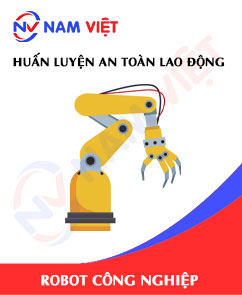Occupational Safety Training for Industrial Robot Manufacturing
99,000 ₫
Note: The above price is calculated for one person, and the price may fluctuate depending on the number of learners participating in the course and market movements. For more accurate pricing support, please refer to the price list or contact our consulting staff directly.
Occupational safety is an important issue in industrial robot manufacturing factories and needs to be addressed promptly to ensure the health and safety of workers and enhance the reputation of enterprises. The Occupational Safety Training course is one of the effective solutions to raise awareness on how to prevent workplace accidents for workers participating in industrial robot manufacturing.
Table of Contents
Toggle1. Overview of industrial robots
a. What is an industrial robot?
Industrial robots are automated machines or automated systems designed to perform tasks in an industrial environment. They are programmed and configured to perform specific tasks, often repetitive or hazardous jobs for humans.
Industrial robots can come in many forms and sizes, from compact handheld robots to large automated systems with entire rows of robots working together. They can be used in many industries, including automobile manufacturing, electronics, assembly, metal processing, food and packaging, logistics, and many other fields.
Industrial robots are often equipped with sensors and controllers to monitor and control their operations. Modern technologies such as artificial intelligence, machine learning, and human-machine interaction are also integrated into industrial robots to enhance their capabilities and performance.
The goal of industrial robots is to increase productivity, achieve higher quality, reduce manufacturing costs, and improve worker safety. They can perform tasks such as welding, cutting, machining, assembly, transportation, and product quality inspection.

b. Types of machines for industrial robot manufacturing
There are many types of machines involved in the process of manufacturing and assembling industrial robots. Below are some examples of common types of machines:
- CNC machining machines (Computer Numerical Control): CNC machines are used to process metal or plastic parts according to digital designs. They are computer-controlled and capable of precise and repeatable machining.
- Injection molding machines: Injection molding machines are used to create plastic parts of industrial robots. They usually operate by melting plastic into molds and solidifying it into the desired shape.
- Robot welding machines: Robot welding machines are used to perform welding tasks in the robot assembly process. They are programmed to move and carry out welding according to specific positions and angles.
- Laser cutting machines: Laser cutting machines are used to cut metal or plastic parts according to specific patterns and dimensions. They use laser technology for accurate and fast cutting.
- Transport machines and collaborative robots: Transport machines, conveyors, and collaborative robots are used to transfer and transport parts and components in the robot assembly process. They help automate transfer and flexible movement of parts.
- Inspection and quality control machines: Inspection and quality control machines are used to test and ensure the quality of parts and robots after assembly. They can use technologies such as spectrometers, precision measuring machines, vision systems, and sensors to check and evaluate technical parameters and performance.
These machines are often used together in the manufacturing and assembly process of industrial robots to achieve the best performance and quality.

c. Industrial robot manufacturing enterprises in Vietnam
Currently, Vietnam has several enterprises manufacturing industrial robots. Below are some examples:
- FPT Robot: FPT Robot is a subsidiary of FPT Group, focusing on research, development, and manufacturing of industrial robot solutions. This company has manufactured and developed types of robots used in industry, such as welding robots, material handling robots, collaborative robots, and industrial automation services.
- KUKA Vietnam: KUKA is a German technology group, and KUKA Vietnam is its branch in Vietnam. KUKA Vietnam provides industrial robot solutions, including welding robots, assembly robots, collaborative robots, and other industrial automation systems.
- CadoVn: CadoVn is a Vietnamese technology company specializing in automation and industrial robots. This company manufactures and distributes types of industrial robots such as welding robots, pick-and-place robots, assembly robots, and automation systems for many different industries.
- TOSY Robotics: TOSY Robotics is a technology company based in Vietnam, known for manufacturing and developing entertainment robots and educational robots. Although not mainly focused on industrial robots, TOSY Robotics has also introduced some industrial robot solutions in its development process.
These are just some examples of industrial robot manufacturing enterprises in Vietnam and not a complete list. The industrial robot industry is rapidly developing in Vietnam, and there may be many other enterprises participating in the future.

d. Specific jobs in industrial robot manufacturing factories
Group 1
- Executive director, deputy executive director, department head in industrial robot manufacturing factories.
Group 2
- Safety officer: manage safety in the factory, design safety procedures, supervise and enforce employees to comply with safe working procedures.
Group 3
- Part fabrication: Part fabrication work includes metal processing, plastic molding, cutting, welding, and machining the necessary parts and components to assemble robots. CNC machines and other fabrication methods are used to precisely process the parts.
- Assembly: Workers and technicians assemble parts and components to form complete robots. Assembly processes include attaching mechanisms, motors, controllers, sensors, and other parts according to technical instructions and drawings.
- Programming and configuration: Technicians program industrial robots to perform specific tasks. They set up programs and configure robots to control movement, communicate with other systems, and perform manufacturing tasks.
- Inspection and quality control: Robots are inspected and tested for quality to ensure correct operation and compliance with quality standards. Inspections include checking movement, performance, accuracy, and ability to meet requirements.
- Packing and transportation: After the robot is completed and tested, it is packed and prepared for transportation to the usage site. Packing includes protecting the robot, boxing, and labeling to ensure safety during transport.
Group 4
- Office work, service, sales, marketing.
- Manufacturing management, quality management, human resource management, material management, financial accounting management.
- Design and research: Engineers and research teams take on the work of designing and developing models and technical drawings for robots. They study new technologies, generate creative ideas, and optimize designs.
2. Overview of occupational safety training in industrial robot manufacturing
In this article, we focus on issues surrounding group 3, because group 3 is the group directly involved in manufacturing, facing the highest occupational safety risks. Refer to other groups here
a. What is occupational safety training group 3?
- Occupational safety training group 3 are lessons that provide awareness of how to prevent occupational accidents for workers.
- The occupational safety training course will help workers recognize and avoid hazards, reducing the risk of occupational accidents during work.
REGISTER FOR OCCUPATIONAL SAFETY TRAINING SERVICE
b. Training duration
Initial occupational safety training duration
- Total training duration is at least 24 hours, including examination time.
- 8 hours of theoretical study on the system of occupational safety and hygiene policies and laws
- 8 hours of theoretical study on basic occupational safety and hygiene knowledge
- 4 hours of theoretical study on specialized training content
- 2 hours of practical training on specialized training content
- 2 hours of theoretical examination at the end of the training course
The occupational safety training center will allocate time into several training sessions depending on the training schedule arrangement for employees. However, typically, there will be 6 training sessions, and the course will last for 3 days, provided that the manufacturing enterprise arranges continuous training time.
Periodic occupational safety training duration
- Before the occupational safety card expires, workers who want renewal must undergo a periodic occupational safety training course, with periodic occupational safety training duration being at least 50% of the initial occupational safety training duration.
Explanation: total periodic occupational safety training duration is at least 12 hours, including examination time. After completing the periodic training and passing the test, workers will be reissued and extended their occupational safety card.
c. Content of the training course
| No. | TRAINING CONTENT | TRAINING DURATION (HOURS) | |||
| Total | Including | ||||
| Theory | Practice | Examination | |||
| I | System of occupational safety and hygiene policies and laws | 8 | 8 | 0 | 0 |
| 1 | Overview of the system of legal documents on occupational safety and hygiene. | 6 | 6 | ||
| 2 | System of occupational safety and hygiene standards and technical regulations. | 1 | 1 | ||
| 3 | Specific regulations of state management agencies on occupational safety and hygiene when building new, expanding, or renovating facilities to manufacture, use, store, and inspect types of machines, equipment, materials, and substances with strict occupational safety and hygiene requirements. | 1 | 1 | ||
| II | Basic knowledge of occupational safety and hygiene | 8 | 8 | 0 | 0 |
| 1 | Basic knowledge of hazardous and harmful factors in the workplace. | 4 | 4 | ||
| 2 | Methods to improve working conditions. | 1 | 1 | ||
| 3 | Safety culture in manufacturing and business. | 1 | 1 | ||
| 4 | Rights and obligations of employers and workers; occupational safety and hygiene policies and regimes for workers; functions and duties of the occupational safety and hygiene network. | 1 | 1 | ||
| 5 | Occupational safety and hygiene regulations, signs, instructions, and use of safety equipment, personal protective equipment; skills and expertise in first aid for occupational accidents and prevention of occupational diseases. | 1 | 1 | ||
| III | Specialized training content | 6 | 4 | 2 | 0 |
| Comprehensive knowledge of types of machines, equipment, substances generating hazardous and harmful factors; analysis, evaluation, and management of occupational safety and hygiene risks; safe working procedures with machines, equipment, and substances with strict occupational safety and hygiene requirements. | 6 | 4 | 2 | ||
| IV | Final occupational safety training examination | 2 | 2 | 0 | 0 |
| Total | 24 | 22 | 2 | ||
See more training content of 6 groups
d. Occupational safety card
After completing the occupational safety training course and passing the test, workers will be issued an occupational safety card (commonly called a occupational safety certificate for group 3).
The group 3 safety card will clearly show information such as full name, date of birth, job, and specific working environment. It also includes training duration, red seal, and signature confirming course completion.
According to regulations on issuing safety cards stated in clause 2 article 24 decree 44/2016/ND-CP, there are 2 cases:
- In case the employer and the worker have a labor contract with each other, the employer must sign, stamp, and seal the safety card for workers belonging to group 3 after they have completed the occupational safety training from the training unit and passed the test.
- In case of freelancers or seasonal workers without a labor contract, the training unit must sign, stamp, and seal the safety card for the worker after they have completed the occupational safety training from the training unit and passed the test.

3. Identifying hazards affecting workers in industrial robot manufacturing
During the process of industrial robot manufacturing, several hazards may affect workers. Here are some major hazards that must be identified and addressed in the process of industrial robot production:
- Hazards related to machinery: The machines used in industrial robot manufacturing can cause physical dangers such as collisions, cuts, crushing, or impacts. These can result in serious injuries to workers if safety is not ensured and protective rules are not followed.
- Hazards from materials and substances: In industrial robot manufacturing, hazardous, flammable, explosive, or irritating substances may be used. Exposure to these materials can harm the health and safety of workers.
- Hazards from welding and cutting tasks: Welding and cutting work during robot assembly can create risks of fire, explosion, radiation, smoke, high temperatures, and fine particles that may harm the eyes and respiratory system of workers.
- Hazards from mobile robots: When working with mobile robots, there are risks of collision, impact, and crushing caused by robot movements. This is especially critical in environments where humans and robots work together, requiring safety measures to ensure worker protection.
- Electrical hazards: During industrial robot manufacturing, working with electrical systems, wiring, and electrical equipment can pose electrical risks such as short circuits, power surges, fires, explosions, or electric shocks.

4. Common occupational accidents in industrial robot manufacturing
In the process of industrial robot manufacturing, there are several types of occupational accidents that commonly occur. Below are some of the most frequent accidents workers may face:
- Collisions and impacts: Workers may suffer accidents due to collisions or impacts with machines, robots, or other objects during work. These may result in injuries, wounds, or fractures.
- Cuts and punctures: While working with metal cutting machines or sharp tools, workers may suffer cuts or puncture injuries. This can occur during material cutting or when handling small robot components.
- Burns and thermal injuries: Working with high-temperature equipment such as welding machines, laser cutters, or heating systems can cause burns or thermal injuries to workers.
- Chemical poisoning: Industrial robot manufacturing may involve hazardous chemicals. Workers may face risks from direct contact, inhalation, or accidental ingestion of such chemicals, leading to chemical poisoning.
- Electrical accidents: When working with electrical systems, wiring, and equipment, workers may face risks of short circuits, power surges, fire, explosions, or electric shocks.
- Transport and movement accidents: During robot transportation or relocation, workers may encounter traffic accidents or accidents while moving robots from one location to another.
5. Safety measures in industrial robot manufacturing
Participating in industrial robot manufacturing requires special attention to occupational safety. Here are some important safety measures to implement:
- Ensure the use of personal protective equipment (PPE): Workers must use PPE such as helmets, safety glasses, masks, gloves, protective clothing, and safety shoes to protect themselves from physical and chemical hazards.
- Comply with safety regulations: Follow safety regulations set by robot manufacturers and related legal requirements. This includes familiarizing with manuals, adhering to safety procedures, and knowing how to handle incidents.
- Occupational safety training: Ensure that all workers in industrial robot manufacturing are trained in occupational safety. This includes understanding safe work procedures, equipment and machinery usage rules, and how to respond to hazardous situations.
- Supervise and inspect equipment: Carry out regular supervision and inspections of equipment to ensure safe and effective operation. This includes maintenance, repair, and replacement of damaged or underperforming parts.
- Material classification and management: Ensure proper classification and management of materials. Hazardous or dangerous substances must be handled safely to avoid endangering workers.
- Hazard zone control: Identify and control hazardous zones in industrial robot manufacturing facilities.
- Regularly conduct occupational environment monitoring in factories to collect and analyze harmful factors, thereby reducing hazards to prevent occupational diseases.
6. Benefits of occupational safety training in industrial robot manufacturing
An Toan Nam Viet provides your business with significant benefits after completing occupational safety training courses in compliance with Decree 44/2016/ND-CP on occupational safety and hygiene:
- Workers can identify potential occupational accident risks and take preventive measures to avoid accidents.
- Your business can establish risk prevention measures in manufacturing, operation, and maintenance processes.
- Reduce costs incurred due to unsafe working conditions.
- Uninterrupted production ensures increased productivity and product quality.
- Ensure compliance with occupational safety laws and avoid legal risks.
- Create reputation and professionalism in all aspects, thereby enhancing your business brand.
The training courses provided by An Toan Nam Viet are preventive solutions against external factors that may endanger individuals, helping them avoid injuries or fatalities.
REGISTER FOR OCCUPATIONAL SAFETY TRAINING SERVICE
7. Customer feedback after completing occupational safety training in industrial robot manufacturing
An Toan Nam Viet has many years of experience in accompanying businesses across Vietnam in general and particularly in the southern provinces. That responsibility is extremely valuable to Nam Viet, which is why the occupational safety training work of Nam Viet is increasingly focused on professionalism. The motivation for An Toan Nam Viet to grow strongly today comes from both positive feedback and suggestions from businesses. Below are responses from our partners we have served.
Bac Nam E&C Construction Investment Joint Stock Company
“The first time using the service at An Toan Nam Viet, I was very surprised by the enthusiastic 24/7 support from the consulting team. The class organization was very quick and convenient for our company, thank you very much for the service of Nam Viet!”
Hoa Dat Construction and Trading Joint Stock Company
“The service of Nam Viet helped us a lot in simplifying labor safety and completing safety documentation for the work process. The consulting team was enthusiastic and timely in responding to our questions. 5 stars for Nam Viet.”
See more customer interviews after using the service of An Toan Nam Viet
8. Occupational safety training capacity of An Toan Nam Viet
An Toan Nam Viet is a reputable and high-quality occupational safety training center in Vietnam today. Training sessions are continuously conducted at factories, manufacturing plants, and construction sites nationwide (63 provinces in Vietnam).
REGISTER FOR OCCUPATIONAL SAFETY TRAINING SERVICE
Occupational safety training license
- An Toan Nam Viet has been inspected and certified by the Department of Occupational Safety under the Ministry of Labor, War Invalids, and Social Affairs as meeting the conditions to operate occupational safety and hygiene training. This further strengthens our occupational safety training capability.
Training materials and lectures
- Before occupational safety training materials are used in occupational safety training courses, they are reviewed and verified to ensure accuracy and effectiveness in application.
- Our instructors’ teaching methods are standardized according to An Toan Nam Viet’s teaching standards, which have been researched and refined by occupational safety training experts to maximize learners’ knowledge absorption.
Facilities
- Controlling classroom factors affecting the training process increases teaching efficiency and learners’ knowledge absorption.
- Our training facilities always include spacious classrooms that meet standards for size, lighting, and training equipment.
9. Reputable and high-quality national occupational safety training center
At An Toan Nam Viet, we always place our dedication to occupational safety training as our top priority. For us, imparting knowledge that helps workers know how to protect themselves, so they have a safe foundation on their path of livelihood, is a contribution to building the nation.
To ensure effective training, we prepare carefully and meticulously in every detail, even the smallest ones. From preparing tools, teaching equipment, curriculum, documents, sound, and lighting.
Our occupational safety training instructors are experts with many years of experience in the field. They even have research works on identifying hazards in all industries and ways to prevent them.
The lectures of our instructors are drawn from real-life experience and delivered in the most vivid and understandable way to workers. These factors make workers feel comfortable during training sessions and better absorb the knowledge we provide. Of course, the knowledge conveyed is always closely aligned with Decree 44/2016/ND-CP.
From there, workers acquire many measures to prevent hazards and protect themselves, while also applying them appropriately in their actual work.
Our occupational safety training center is proud to be a reputable and professional provider of occupational safety training services with the following advantages:
- Competitive training costs while ensuring training quality.
- Flexible training schedules adapted to the manufacturing situation of enterprises.
- Quick and legally compliant procedures for issuing occupational safety training certificates.
- Training instructors with many years of experience in the profession.
- Classrooms are controlled for factors affecting the training process, increasing teaching efficiency and learners’ knowledge absorption.
- Lectures compiled to suit occupational safety work at enterprises.
- An Toan Nam Viet works with dedication and professionalism to support customers accurately and quickly.

10. Additional reference materials for occupational safety training in industrial robot manufacturing
- Occupational safety training materials for industrial robot manufacturing
- Occupational safety training document set
- Occupational safety training test set
- Occupational safety training curriculum for industrial robot manufacturing
- Occupational safety multiple-choice test for industrial robot manufacturing
1 review for Occupational Safety Training for Industrial Robot Manufacturing
No comments yet















namchinh.haiphong341
Hài lòng nhé!